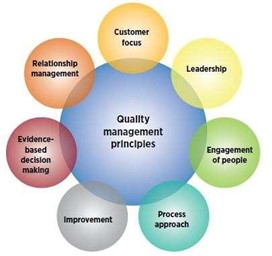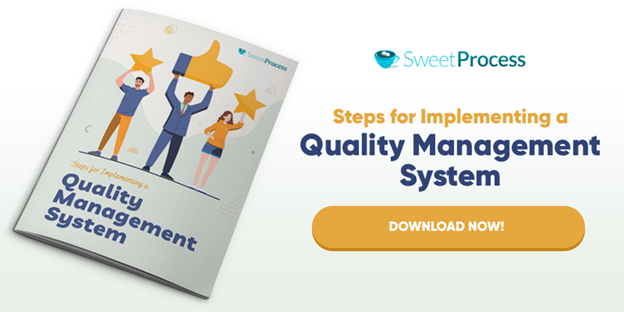Last Updated on July 27, 2024 by Owen McGab Enaohwo
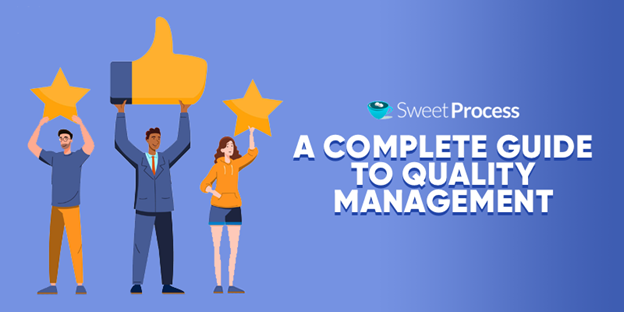
We’ve all been in a situation where we were presented with more than one option to choose from, and we only went after the one we perceived was of higher quality. We humans naturally prefer a higher-quality product over one of lower quality.
Now, what happens to all those products that customers rejected for being of low standard? How does the company that produces such low-quality goods survive in a competitive market? The answer is not a good one. However, that’s the story for a company without a culture of quality management. Customers will move to the competition to get better value for their money.
As a business owner, you’re well aware that customers will continue coming to you when they know that you will deliver them the product or service they need, and you’ll always meet or exceed their expectations. Quality management is an approach for organizations to tap into to make sure that customers always come back. It is a way for you to make better products and deliver better services that your customers will be grateful for.
This article provides information on all you need to know about quality management, including the benefits, the risks, methods, and how to set up a quality management system.
Chapter 1: What is Quality Management?
Chapter 2: What is a Quality Management System?
Chapter 3: Benefits of Quality Management
Chapter 4: Obstacles to Quality Management
Chapter 5: The Risks of Not Having a Quality Management System
Chapter 6: Quality Management System Methods
Chapter 7: Setting up a Quality Management System
Chapter 8: Where SweetProcess Comes in Quality Management
Chapter 1: What is Quality Management?
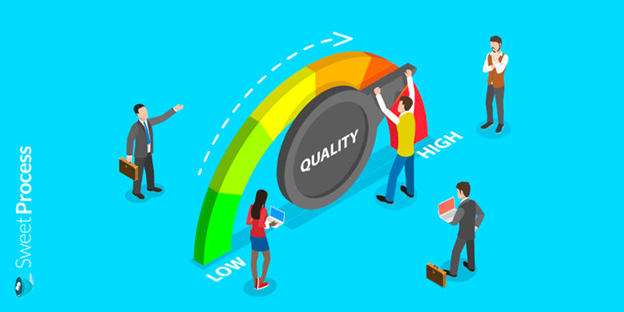
Quality is simply delivering a product or service in a way that meets the expectations of a customer. It is providing products or services to customers that are free from deficiencies and errors. Quality can also be said to be how good something is when compared to others. The term quality is subjective in that what a customer will appreciate and find useful in a product may be different from that of another customer. However, there are dimensions of perceived quality from the customers’ perception of the overall quality of your product or service. Let’s look at them.
Performance: It refers to a product’s primary operating characteristics. How does your product perform? Does it do what it says it will do?
Features: Features are additional characteristics that enhance the appeal of the product or service for the user. What features does your product have? Are they what the customer finds useful?
Conformance with specifications: This is the extent to which a product’s design and operating characteristics meet established standards.
Reliability: This is the likelihood that a product will not fail within a specific period. Is your product or service reliable?
Serviceability: This is the speed with which the product can be put back into service when it breaks down.
Fit and finish: This is the appearance of your product.
Durability: Durability is a product’s functional life cycle, or how long it can be used before it needs repair.
Quality Management
Quality management includes everything you do to make sure you produce and deliver your company’s products and services at the appropriate cost while meeting the expectations of your customer. Not just that, but quality management allows managers to resolve customer complaints and get more positive feedback. It has four components: quality planning, quality assurance, quality control, and quality improvement.
Quality Planning
This is the first step in quality management. It is the process of identifying the quality standards relevant to the project and deciding how to meet them. Quality standards are necessary and guide stakeholders on how quality management will be performed on a project. After identifying quality standards, the next step is writing a quality policy.
Quality Assurance
These are the systematic actions necessary to offer sufficient reliability that particular service or product will meet the specified requirements. It provides assurance that the project is proceeding according to agreed plans. Measure the effectiveness of your processes and capture lessons learned as you implement changes. Also, identify areas of non-compliance and opportunities for improvement.
Quality Control
This is the continued effort to uphold a process’s integrity and reliability in achieving an outcome. It is done by checking if a product meets expectations. Identify errors that need to be corrected and processes that are unnecessary for production.
Quality Improvement
Quality improvement is the purposeful change of a process to improve the confidence or reliability of the outcome. As you observe your data regarding your processes, find out how you can improve on them to achieve even better results.
A Brief History of Quality
The quality movement started way back in the 13th century. It can be traced to Medieval Europe, where craftsmen began organizing into unions called guilds. These guilds developed rules for product and service quality. Inspection committees enforced the rules by marking flawless goods with a special symbol.
After entering the Second World War, the U.S was concerned about the safety and quality of its military equipment. They had a large number of inspection forces responsible for inspecting every unit of equipment produced. Sampling tables were adopted and published in a military standard known as MIL-STD-105. These tables helped suppliers understand exactly what they were expected to produce. Walter Shewhart’s statistical quality control was given as a training course to suppliers.
At the beginning of the 20th century, Walter focused on controlling processes. He concluded that data could be analyzed using statistical techniques to see whether a process is stable and in control. He laid the foundation for control charts. He developed it as a means of addressing procedural problems before mistakes could harm products. His method enabled employees to track changes in processes and product output using a chart.
W. Edwards Deming became a proponent of Shewhart’s SQC methods. He refined Shewhart’s concepts, landing finally at what we now know as continuous quality improvement. He was influenced by the Shewhart line. The Shewhart line is a three-step scientific process of specification, production, and inspection. Deming reasoned that results would be better if the steps were in a cycle rather than a straight line. The Shewhart line then became known as the Shewhart cycle. In 1950, Deming further improved on Walter’s idea and created a new version known as the Deming wheel or cycle. This concept’s newest modification is now known as the PDCA cycle.
After the Second World War, Japan welcomed input on how to improve quality from foreign companies and lecturers, including W. Edwards Deming and Joseph Juran. Japanese manufacturers focused on improving organizational processes through their customers. They produced higher-quality goods at low prices. American manufacturers saw this competition and thought the Japanese success was price-related, and so they built strategies aimed at cutting costs but didn’t improve quality. The Japanese continued to lead as a result. US manufacturers gradually adopted quality standards for their operations, including total quality management.
Chapter 2: What is a Quality Management System?

A quality management system (QMS) is a set of internal rules defined by a collection of policies, processes, documented procedures, and records. It defines how a company will create and deliver products and services. It can also be defined as a collection of business processes and functions aimed at the continued improvement of quality to see that customers’ expectations are met. It is a method companies use to ensure that their businesses run according to standards.
A QMS works best when it is tailored to your company’s needs. Having a QMS enables you to reach customer requirements and helps your organization remain compliant with the latest quality standards and regulations.
Principles of Quality Management
Principles of quality management are a set of fundamental beliefs, norms, and values that are accepted as true and can be used as a foundation to guide an organization’s performance improvements. The principles are listed below.
Watch this video to learn more about the principles.
Customer Focus
The customer is the central focus of a quality management program. When you look at your products and services, you consider how you can improve them to suit the customer better. Get customer feedback, listen to the customer when they complain or when they commend you, and tailor your quality improvement to fix or fit whatever it is the customer is providing feedback about. Quality improvement cannot be made without involving the customer since they are the reason why you are in business in the first place. Hence, quality management is mostly customer-centric.
Leadership
Leadership at all levels establishes unity of purpose and creates conditions in which people are engaged in achieving the organization’s quality objectives. Leaders communicate the strategic direction and objectives throughout the organization. They encourage the organization’s commitment to quality and provide training.
Engagement of People
While you are working on improving quality in your work environment, you should engage all employees from top to bottom. The input of all members of your organization is very necessary. All of them might have important contributions to give regarding your business processes since they all handle different aspects of it. They may also have considerable insight on how to improve the processes they are currently engaged in. Use employee reward and recognition to empower your employees to suggest and implement improvements. Provide adequate training to equip them with the right skill and knowledge.
Process Approach
Good processes result in improved consistency, reduced costs, quicker activities, waste removal, and continuous improvement. Leadership should be able to manage and control the inputs and outputs of their organization to boost efficiency. A process approach educates everyone involved in the production cycle about how various inputs and outputs interrelate and, when executed correctly, how those interactions contribute to overall system efficiency.
Improvement
Quality management is about improving your business and making it better so you can’t ever be satisfied with where you are right now. You’ll always be seeking to improve. That’s the thing about attaining quality. There is no end to it. Take it to be a continuous race where you keep hitting different milestones, keep making great advancements but never reaching the finish line. Through the continuous application of short-term initiatives, your long-term goals can be achieved.
Evidence-Based Decision-Making
Another thing with quality management is that data must be used in decision-making. Whatever conclusion you make must be based on previously captured data. You do not work based on intuition or guesses. Carry out experiments, record your processes, and know which works optimally and which does not. With this data, you can observe and better understand how to improve your business. Document functional processes across your organization as this is very necessary for making changes.
Relationship Management
Your relationship with internal and external members of your organization matters in the success of your quality management program. This includes relations with your employees, suppliers, and society. You have to have a good relationship with everyone on your supply chain. They should understand your goals and know what your organization stands for.
Purpose of Quality Management
What does quality management do for your organization? The goals of quality management have been listed below.
Eliminate Errors and Reduce Waste
Quality management eliminates errors and reduces waste in an organization. By looking at your processes and improving them, it takes care of inefficient and unhelpful processes. The proactive nature of quality management ensures that errors are prevented from happening. And even if there is a mistake, there is a solution in place to fix it. As a result, waste is reduced. A functional QMS will provide the framework for process re-evaluation and improvement when an error occurs. Deal with errors as soon as they occur and don’t ignore them.
Enhance Customer Satisfaction
Customers are satisfied when their needs are met. Improving the quality of a product and service will ensure that your customer is satisfied and comes back for more. With a quality management system, you’re able to maintain your existing customers while creating a reputation for quality that will bring more clients your way.
Deliver Quality Products and Services
Using a quality management system helps you achieve and maintain a desired level of quality within your organization. Your product and services will not fall short of standard as your quality management system ensures that all that is produced meets the standard. It takes care of variations in production and creates uniformity.
Elements of Quality Management

The elements of quality management are the foundation for setting up a QMS in your organization. These include all the activities that your company uses to direct, control, and coordinate quality.
Organization Quality Policies
Quality objectives and policies are designed to encourage organizations to define strategic goals and purposes for their quality management system. Define what quality means within your company. Your policies should be scalable and flexible in case changes have to be made. Quality objectives should provide a clear vision for every member of the organization to understand the company’s purpose and the value of a QMS. Having this lets your employees and customers know the direction of your company with respect to quality.
Data Management
This is how an organization manages information and data for secure and structured access and storage. Provide meaningful data evidence of effective quality controls and drive continuous improvement. Conversely, organizations with ineffective data management practices can experience inconsistent product quality, operating inefficiencies, compliance risks, poor customer satisfaction, and low profitability.
Internal Process
Before setting a QMS, identify and define all organizational processes that use any resource to transform inputs into outputs.
Quality Manual
The quality manual is the documentation of a QMS. It states the motivation for adopting a QMS framework and the role of quality within an organization. It enables you to communicate what you want to achieve by emphasizing quality throughout your organization. It also explains all the requirements of the quality standard you’re using.
Customer Satisfaction
Quality management ensures that customers are constantly satisfied. Monitor customer satisfaction to determine if quality objectives are achieved by using surveys and complaint management procedures
Organizational Structure
This states how your organization is structured from top to bottom. It explains the roles that are expected to be carried out by each person. The organizational structure documentation should address the entire product lifecycle.
Continuous Improvement
Design organizational processes to meet QMS standards for continuous improvement. This requires clear documentation of controls across the organization. The document should include quality planning procedures, compliance requirements, safety design, corrective action, and innovation.
Document Control
Document management systems contain all evidence necessary to prove QMS performance objectively. It includes quality objectives, a quality manual, procedures, process documentation, and records keeping. Document control helps you to enforce controlled processes and practices within your company.
Costs of Quality
Quality costs are the costs associated with preventing, detecting, and resolving product issues related to quality. In other words, it is a way of measuring the costs associated with ensuring that a culture of quality thrives in an organization, as well as the costs associated with quality failures.
There are four major types of quality costs.
Prevention Costs
Prevention costs result from designing and implementing a QMS. It is incurred by keeping a quality problem from happening. The costs include quality planning, employee training, and quality assurance. It is the least expensive type of quality cost.
Appraisal Costs
Like the prevention cost, appraisal cost is a cost incurred to keep a quality problem from happening. A variety of inspections are carried out, from measuring the effectiveness of a quality management system to manufacturers supervising existing staff and the supply chain.
Internal Failure Costs
Internal failure cost is from screening for and discovering quality failures before products or services are delivered to customers. They include waste from poor processes, excessive scrap, rework to correct errors, and the activity required to diagnose the cause of quality failure.
External Failure Costs
Repair, warranty claims, returns, and dealing with customer complaints are external costs. They are the most expensive costs and are only incurred after the products or services have reached the customer.
Chapter 3: Benefits of Quality Management

Implementation of a quality management system should result in many long-term financial gains.
This YouTube video gives more explanation.
Satisfied Customers
Satisfying your customers is a driving force for having a system of quality in your organization. A quality management system helps achieve this perfectly for you. It makes sure your customers are always satisfied with your products and services. This is because you are constantly producing high-quality products and delivering high-quality services. High-quality products and services that meet the customers’ needs will result in higher customer satisfaction. You’ll get more customers too.
Organization Culture
A QMS creates, communicates, and aligns operational activities with the goals and priorities of the organization so that all employees are aware of the expectations. An organization that implements a system of QMS develops and nurtures core values around quality management and continuous improvement. Your employees will be conscious of quality in their daily activities.
Lower Costs
Implementing a system of quality management in your organization will ensure that you have lower expenses as a result of fewer product defects and replacements. It reduces the cost you would have had to correct errors. Your resources are put into profitable areas of your organization.
Documentation
QMS defines how critical processes and goals are documented so that important knowledge is available throughout the company.
Fewer Product Defects
Your products will have fewer defects if you are operating a system of quality management. This is because errors are brought to a minimum, making your product come out with fewer defects, thereby saving you time and ensuring that quality remains the same throughout production.
Organizational Effectiveness
Quality management doesn’t only serve the customers. It also improves the work environment in your organization by making sure things are in order. Your organization will become organized and there will be less room for confusion. An organization where everyone knows what their duty is and how they are supposed to do it will deliver on the customer expectation every time.
Increased Customer Loyalty
Having loyal customers is a dream of all businesses. You can have this using a QMS. Customers will stay loyal to you when they see that you can give them what they are looking for. When you meet their needs and even exceed their expectations, there is no need for them to go out to look for what you can offer.
Decreased Turnover Rate
Another area where quality management helps your organization, in particular, is in reducing the turnover rate. When employees are engaged and feel valued and respected, they will not want to leave. An effective quality management system includes the employees and doesn’t exclude or leave them out of decision-making processes. If your employees feel that they are a part of an organization where their input is valued and considered, they will most likely not want to leave, since they are in a healthy environment where they can grow.
Improved Organizational Process
A benefit of a quality management system is that it stimulates businesses to continuously reassess their processes and output. This exercise, at the same time, provides the opportunity to identify other areas of improvement, in turn enabling the creation of added value.
Compliance
By implementing a quality management system, including documentation systems, companies can quickly and easily ensure that their processes comply with standards and regulations. Such systems also provide the availability to conduct audits and reports, making it easier to monitor compliance and adjust if necessary.
Chapter 4: Obstacles to Quality Management

There are a few obstacles you may come across as you begin implementing a quality management system. These obstacles can be overcome if you know what to do. You can also avoid them totally by removing an obstacle before it becomes a problem. Some of the obstacles you may encounter are:
Lack of Motivation
Your employees might not see the importance of having a system of quality management operating in your business. Failure to see this need will make it difficult for them to follow your lead for quality improvement. To overcome this obstacle, clearly communicate why they have to embrace a culture of quality in your workplace. Help them understand your goals and know why it is necessary for them to embrace a system of quality in their jobs. If everyone is not on the same page, your improved processes may not make any difference since people control the process.
Unnecessary Documentation
Having documents unrelated to your business processes can be quite annoying for your employees to follow through. When there are just too many documents, the important details can get mixed up with the minutia and leave the employees feeling frustrated. To overcome this, your document process should be organized so it strictly contains those processes that are relevant to the day-to-day operation of your organization.
Too Much Work
An overworked staff will hinder your quality management system from being productive. Your staff should not be overloaded with work if you want them to be efficient. While you try to get work done with less staff to save money, make sure you’re not overburdening your employees.
Disorganized Organization
Documents regulate and control your business systems, processes, functions, and procedures. Therefore, your documentation system should be an effective and efficient one that keeps your organization running smoothly.
Risk Management
QMS manages risk for both individual tasks and across functional procedures. Using data that is captured, deviations, errors and impacts can be measured and tracked.
Resistant to Change
Employees can resist change for any reason, even if the change is good. It could be fear of losing their jobs, cynicism, or skepticism. Effective communication can help them accept changes. Let them know that the reason why a change is happening is for a good reason and will affect them positively.
Not Having a Good Plan
A quality system should be planned carefully for it to be effective. Carefully consider the needs of your customer and how you’re going to meet them. Outline your strategy for implementing changes. A poorly planned quality system will frustrate your efforts.
Rigid Nature of QMS
A quality management system should not be rigid. Rather, it should be flexible enough to adapt to changes. When you notice that a method is not working for you, do not stick to the old but rather be open to trying other quality management approaches.
Little Attention to Customers
As mentioned earlier, when implementing a quality management system, your customers’ wishes should not be ignored. Doing this will be like going to the construction site without any construction equipment. Having your customers in mind is very important for achieving your quality goals. Focus on your customer needs and expectations and make your changes from there, and you will see how your plan will yield good results.
Chapter 5: The Risks of Not Having a Quality Management System
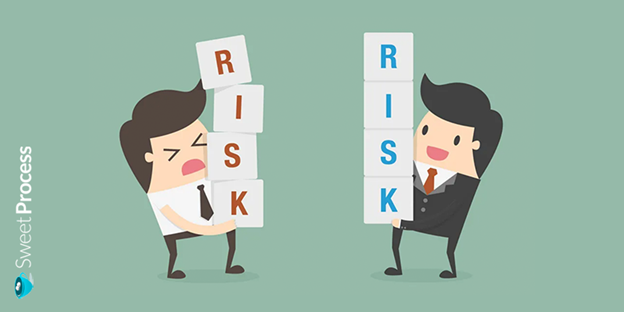
The downsides of not having a quality management system are too costly to ignore. Hopefully, you will seriously consider implementing a quality management system after learning about the risks of not having one.
Lack of Continuous Improvement
An organization without a quality management system will suffer a lack of improvement. For an organization to continue doing well in the market they have to have a system of quality management. Otherwise, they lose value in the market, they lose a customer, and eventually go out of business. To not be continuously improving means that you are missing out on new trends that are happening—such as new standards and new expectations of your customers—and that is bad for business.
Disengaged Workforce
Quality management has, as its core principle, the engagement of people. The people here refer to your employees. A lack of quality management in your organization means that your employees will not be contributing much to your processes because their insights will not be valued. Such an organization will create a disengaged workforce because your employees do not see the need to contribute to be better, so there is no motivation for them to improve. This affects the overall performance of your employees.
Lack of Customer Satisfaction
Not having a quality management system in your organization will mean that your customers will not be satisfied with your product because you’re not interested in quality. Your customers will go somewhere else to find the qualities you are lacking, and if this continues—if your customers are dissatisfied and their expectations are not being met—then your business will suffer.
No Document Control
Poor control of documentation is a risk of not having a quality management system. A QMS makes sure that your organization is organized. It helps you effectively and efficiently document your processes and procedures so that there is little confusion and few mistakes in the day-to-day running of your business.
Chapter 6: Quality Management System Methods
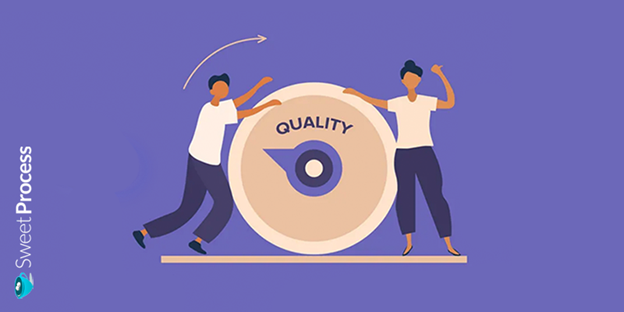
Several different quality management methods are available to choose from. The correct type of QMS for your organization will depend on your industry, as different standards apply to different industries.
Lean
This is an approach to management that seeks to enhance efficiency and productivity by eliminating waste from business processes.
Wastes
These wastes are recognized in lean management:
Defects: They are imperfections and faults within products or services.
Overproduction: Producing more than is needed.
Waiting: These are holds which cause delays in production.
Unused potential: Not utilizing employees who can add value to processes.
Inventory: A surplus of products or materials in storage that increases cost.
Motion: Unnecessary movements that add no value to a process.
Extra processing: Any activity that is unnecessary to the functioning of a product or service.
Steps of Lean Management
These are the steps to implementing this management approach:
Value: Identify the problem that the customer has. Those activities that do not enable and enhance value should be counted as waste and eliminated.
Mapping: Map out your company’s workflow. Outline the order of all activities and people who contribute to providing the product and service to the customer.
Create continuous flow: Analyze your map and ensure that each workflow runs smoothly and is free from interruption. Remove inefficient processes.
Create pull: Work should be created only when there is a demand for it.
Continuous improvement: Seek ways to continually improve your processes.
Six Sigma
This system aims for perfection in quality. Its focus is on the improvement and reduction of deviations through the application of a specifically outlined process. Six Sigma streamlines quality control in an effort to improve current processes, products, or services by discovering and eliminating defects.
It does so by ensuring there is little or no variance during production. Six Sigma refers to the Greek letter sigma, a statistical symbol representing a standard deviation. Using this approach, a process is expected to be defect-free 99.99966 percent of the time, allowing for 3.4 defects. DMAIC and DMADV are methodologies in Six Sigma. DMAIC is employed in an existing process that isn’t meeting customer needs, while DMADV is used when a business needs to develop a product or process that doesn’t exist.
Six Sigma DMAIC
Define the problem, the customer, project requirements, and the ultimate goals and expectations of the customer.
Measure the performance of the current process. Collect data to determine defects.
Analyze the process to establish the root cause of variation and defects to identify issues with the current strategy that stand in the way of the end goal.
Improve the process by eliminating the root cause of defects through innovative solutions.
Control the new process to avoid falling into old habits and ensure it stays on track.
Six Sigma DMADV
Define realistic goals that suit the customer’s requirements.
Measure and identify the customer’s quality requirements and make them into clear project goals.
Analyze multiple options and alternatives for the customer.
Design the process at a high level before moving to a detailed version that will be the prototype. Identify errors and make modifications.
Verify that all customers and clients approve your final process. After verification, implement the process.
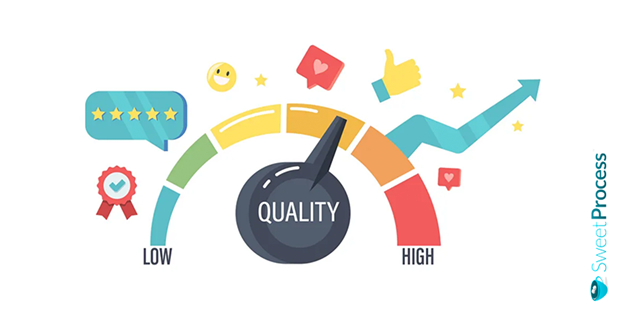
Continuous Quality Improvement
Continuous quality management encourages all team members to continuously ask what can be done better. It provides a framework for organizations to aim for excellence. CQI sees internal and external customer satisfaction as paramount. It is a proactive approach that recognizes that most problems are found in processes, not people.
The PDCA cycle is a methodology in this approach. The PDCA method is an unending cycle of plan-do-check-act. W. Edwards Deming developed this method. Therefore, it is also known as the Deming method. It involves testing possible solutions, assessing the results, and pushing forward with the ones that worked.
Plan: Set your goals and determine the actions needed for change. Collect information about current processes and customer needs.
Do: Test your potential solution by carrying out a small-scale study. Document your findings as you go.
Check: Document lessons learned after implementation. Check to see if your ideas were successful.
Act: After checking your findings, determine what actions need to be taken to improve on your already existing process.
ISO 9000
This is an internationally recognized set of rules, policies, processes, and procedures to provide products and services that meet customer satisfaction. Its abbreviated name is not an acronym but is derived from the Greek word Isos which means equal or equivalent. ISO plays an important role in facilitating world trade by providing common standards among countries. The international organization for standardization was founded in 1947. It develops and publishes standards for a wide range of products, materials, and processes which are reviewed every few years. ISO makes sure that products and services are safe, reliable, and of good quality.
Kaizen
Kaizen is an approach to creating continuous improvement based on the idea that small ongoing changes can lead to significant improvements. It is based on the cooperation and commitment of all employees. Kaizen was first developed in the manufacturing sector to lower defects, eliminate waste, boost productivity and promote innovation. The word Kaizen is a compound of two Japanese words which mean good change or improvement. It is based on the belief that everything can be improved.
Principles of Kaizen
- Let go of assumptions.
- Be proactive about solving problems.
- Don’t accept the status quo.
- Let go of perfectionism and take on an attitude of adoptive change.
- As you find a mistake, look for solutions.
- Create an environment where everyone feels empowered to contribute.
- Don’t accept the obvious issue. Ask why five times to get to the root cause.
- Get information and opinions from different people.
- Use creativity to find low-cost small improvements.
- Never stop improving.
Implementing Kaizen
- Get employees involved.
- Find problems using feedback from all employees and customers. Gather a list of problems and potential solutions.
- Create solutions from your options.
- Test the solution.
- Analyze the results to see how successful a change has been.
- Adopt solutions if the change was positive.
- Repeat the steps to continue improving.
Total Quality Management
Total quality management (TQM) emphasizes quality in every aspect of a business, from top to bottom. The objective of TQM focuses on the long-term development of quality products and services. It does so by breaking down individual processes and activity to determine if it contributes or removes from a company’s productivity and quality goals.
Total quality management is a management framework based on the belief that an organization can have long-term success by having its members focus on improving quality and delivering on customer satisfaction. The objective of TQM is to eliminate waste and increase efficiency. TQM helps to identify skill deficiencies in employees and gives the necessary training to address the deficiencies. TQM creates products that are done right the first time with reduced defects.
Total quality management emphasizes the role teams and individuals play in achieving quality within the organization. Its principles are outlined below.
- Customer-focused: Customer needs drive major improvements that take place in an organization.
- Total employee involvement: Employees are included in the process of improving quality. They are trained to perform better, and their opinions on improvements are considered.
- Process centered: TQM is concerned with how processes contribute to the successful or unsuccessful turn out of products. Hence it focuses on improving the processes so it has few errors.
- Decision-making based on facts: Data collection in TQM is highly regarded as it is the way to understand problems that come up in the company.
- Communication: Clear communication prevents mistakes. Leaders are to communicate their plans and objectives effectively for everyone to understand.
- Integrated system: Departments in your organization are to be interconnected. In an integrated system, everybody in every department should have a thorough understanding of policies, standards, objectives, and processes.
- Strategic and systematic approach: Organizations are to make a proper plan of implementation of their strategies and collect data while applying them.
Chapter 7: Setting up a Quality Management System

Having learned about quality management so far, the last stage is its implementation. This chapter presents the steps simply.
The Process
Design
Begin by creating the framework of your QMS. Design specific business processes to support the system. In this stage, determine the time frame, training plan, and resources needed for implementing your plan. Your QMS policies and objectives come in handy here. Remember that your QMS should be aligned with customer expectations.
Build
Develop internal control activities that are designed to reduce risks associated with new systems. First, provide documents containing information that explain your QMS process. Next, get the required resources you need to implement your quality management procedure. Finally, create process maps and flow charts with detailed work instructions that outline the work process.
Deploy
Share your documented information and quality manuals to get feedback. Train your employees to use the tools and systems. Also, train managers on document control procedures.
Control and Measure
You’ll need a performance evaluation strategy to control and measure the effectiveness of a QMS. Carry out internal auditing. This will reveal the processes that align with your company’s quality policy and objectives. The potential weaknesses of process control will be discovered, and improvements can then be made.
Review and Improve
After implementing the QMS for some time, carry out a management review to see how effective the QMS has been. Make necessary changes.
Quality Management Software
QM software offers a centralized, cloud-based system that helps organizations achieve their goals. They are helpful tools that go side by side with the implementation of your quality system. You should look for the following features when selecting a quality management system software.
Automated quality management workflow: Automated quality management workflows are necessary for monitoring quality complaints. Your QMS software should have automatic workflows.
End-to-end performance reporting: A good QMS should offer end-to-end performance reporting among team members to gain a centralized view of the entire organization.
Risk management: Real-time decision-making saves time, money, and resources. Your software should let you identify risks before they become real problems.
Real-time web-based collaboration: Your chosen software should allow real-time collaboration. This is to allow for quick rectification of errors and improve communication. Team members should be able to make edits and comment on documents.
Chapter 8: Where SweetProcess Comes in Quality Management

To get started on implementing your quality management system, you need a tool that allows you to document your processes and procedures easily. SweetProcess is one such tool. It is a process and procedure documenting cloud-based software that is useful for any company developing a quality management program. Using this software places you in a world of exciting benefits where your customers are constantly pleased with your products and services and your employees function at their best.
See how these companies used SweetProcess to turn their company’s frustration stories into enviable ones.
Jacob Syrytsia, the CEO of AEJuice, had the challenge of getting more customers. The company promotes businesses online by creating videos. They had good products but lacked customers due to a poorly streamlined business process. Using SweetProcess has made his business see tremendous growth.
The absence of documented procedures for internal processes made Jacob the go-to guy for every question asked. Little could be done in his absence. After using SweetProcess in the company, his business functions so well that he focuses on other important areas. His employees confidently carry out tasks without asking repetitive questions.
Michael Cotu, president at Location Accès Crédit, a company that offers financial services for on-road and recreational vehicles in Canada, is another happy user of SweetProcess. Paying attention to details was very important for the success of each vehicle loan application. However, maintaining that high standard was challenging because of the absence of a standard operating procedure.
Lack of proper documentation dealt unfavorably to the company. Then Michael began the search for software that could take care of this problem and offer good security at the same time. SweetProcess offered both, and it has been responsible for the positive changes that took place at the company.
Michel has created a new tagline for SweetProcess—he calls it the holy bible.
“I call this application the holy bible of Location Accès Crédit because everything inside SweetProcess is all our policies and procedures.”
Ted Fogliani is another witness to the awesomeness of SweetProcess. The CEO of ShipCalm has always been process-driven. He was interested in streamlining the operations at ShipCalm, an e-commerce logistics company that offers fulfillment services through omnichannel shipping directly to consumers and retailers. Ted came across some software, but the tools didn’t meet his standards. He then found SweetProcess and it facilitated growth and employee efficiency in his organization.
Find out why these businesses got hooked on SweetProcess by signing up for a free trial.
- Effective Documentation
Documenting processes and procedures with SweetProcess is effective. Videos and pictures can be inserted to aid understanding of a process. Employees can better perform their duties independently with all the information that they need at hand.
- Employee Onboarding and Training
Training employees with SweetProcess doesn’t become tiring, as new employees are exposed to all the information they need to perform well. Self-based training is possible, and hold-ups in tasks get reduced.
Documentation does not only aid onboarding, it’s equally important to document your offboarding checklist to prepare for exiting employees.
- Remote Access to Work Documents
Employees can easily access documents from anywhere using the log-in details. Only authorized persons have remote access to your organization’s processes, procedures, and policies. Customers, too can access a part of your documents, so they know what your company is about.
- Centralized Knowledge Base
A centralized knowledge base gets everyone on the same page. The fear of losing valuable knowledge when an employee leaves is no longer there with SweetProcess. Employees can update processes with permission to include knowledge that wasn’t previously there.
Conclusion
As you’ve seen in this article, nothing beats quality. Having a culture of quality in your organization has so many benefits like customer satisfaction and loyalty, quality products, engaged workforce, decreased costs, reduced errors, and others. The risks associated with not having a quality management system in your organization are just too high when you don’t have a system in place. Even if you think you are not seeing the immediate benefits of a quality management system, slowly but surely, in the long run, you will reap all of the benefits.
If you have decided on installing a QMS, we have a free downloadable checklist to help you on this path. Don’t forget to sign up for a free trial of SweetProcess to get access to great software to assist you with your quality management system implementation. No credit card is required.
